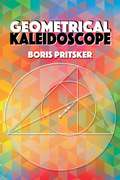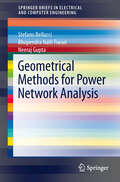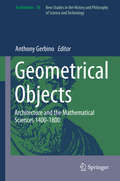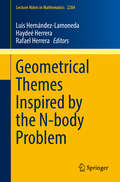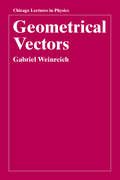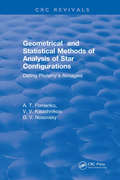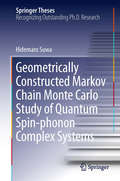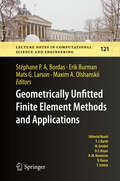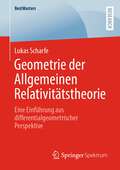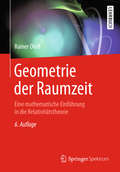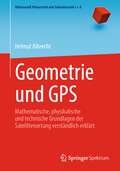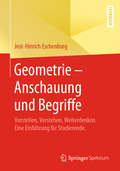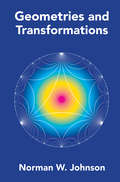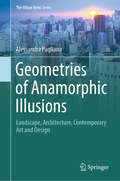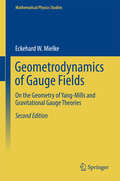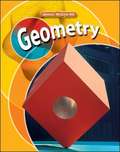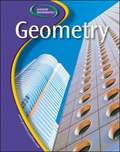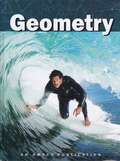- Table View
- List View
Geometrical Kaleidoscope (Dover Books on Mathematics)
by Boris PritskerA high school course in geometry and some curiosity and enthusiasm for the subject are the only prerequisites for tackling this original exploration into the field, long a favorite for readers whose interest in math is not only practical and educational, but also recreational. The book centers on geometric thinking—what it means, how to develop it, and how to recognize it. Readers will discover fascinating insights into many aspects of geometry and geometrical properties and theorems, including such classic examples as Archimedes' law of the lever, Euler's line and circle properties, Fagnano's problem, and Napoleon's theorem.The volume is divided into sections on individual topics such as "Medians of a Triangle," and "Area of a Quadrilateral." Chapters typically begin with some interesting geometrical history, some relevant theorems, and some worked examples of problems followed by problems for readers to figure out for themselves (solutions are provided at the end of the book). The result is a many-faceted exploration, rather like a kaleidoscope, focusing on the mysteries and the pleasures of geometry.
Geometrical Methods for Power Network Analysis
by Stefano Bellucci Neeraj Gupta Bhupendra Nath TiwariThis book is a short introduction to power system planning and operation using advanced geometrical methods. The approach is based on well-known insights and techniques developed in theoretical physics in the context of Riemannian manifolds. The proof of principle and robustness of this approach is examined in the context of the IEEE 5 bus system. This work addresses applied mathematicians, theoretical physicists and power engineers interested in novel mathematical approaches to power network theory.
Geometrical Objects
by Anthony GerbinoThis volume explores the mathematical character of architectural practice in diverse pre- and early modern contexts It takes an explicitly interdisciplinary approach, which unites scholarship in early modern architecture with recent work in the history of science, in particular, on the role of practice in the "scientific revolution" As a contribution to architectural history, the volume contextualizes design and construction in terms of contemporary mathematical knowledge, attendant forms of mathematical practice, and relevant social distinctions between the mathematical professions As a contribution to the history of science, the volume presents a series of micro-historical studies that highlight issues of process, materiality, and knowledge production in specific, situated, practical contexts Our approach sees the designer's studio, the stone-yard, the drawing floor, and construction site not merely as places where the architectural object takes shape, but where mathematical knowledge itself is deployed, exchanged, and amplified among various participants in the building process.
Geometrical Themes Inspired by the N-body Problem (Lecture Notes in Mathematics #2204)
by Luis Hernández-Lamoneda Haydeé Herrera Rafael HerreraPresenting a selection of recent developments in geometrical problems inspired by the N-body problem, these lecture notes offer a variety of approaches to study them, ranging from variational to dynamical, while developing new insights, making geometrical and topological detours, and providing historical references. A. Guillot’s notes aim to describe differential equations in the complex domain, motivated by the evolution of N particles moving on the plane subject to the influence of a magnetic field. Guillot studies such differential equations using different geometric structures on complex curves (in the sense of W. Thurston) in order to find isochronicity conditions. R. Montgomery’s notes deal with a version of the planar Newtonian three-body equation. Namely, he investigates the problem of whether every free homotopy class is realized by a periodic geodesic. The solution involves geometry, dynamical systems, and the McGehee blow-up. A novelty of the approach is the use of energy-balance in order to motivate the McGehee transformation. A. Pedroza’s notes provide a brief introduction to Lagrangian Floer homology and its relation to the solution of the Arnol’d conjecture on the minimal number of non-degenerate fixed points of a Hamiltonian diffeomorphism.
Geometrical Vectors (Chicago Lectures In Physics Ser.)
by Gabriel WeinreichEvery advanced undergraduate and graduate student of physics must master the concepts of vectors and vector analysis. Yet most books cover this topic by merely repeating the introductory-level treatment based on a limited algebraic or analytic view of the subject. <P><P> Geometrical Vectors introduces a more sophisticated approach, which not only brings together many loose ends of the traditional treatment, but also leads directly into the practical use of vectors in general curvilinear coordinates by carefully separating those relationships which are topologically invariant from those which are not. Based on the essentially geometric nature of the subject, this approach builds consistently on students' prior knowledge and geometrical intuition. <P><P> Written in an informal and personal style, Geometrical Vectors provides a handy guide for any student of vector analysis. Clear, carefully constructed line drawings illustrate key points in the text, and problem sets as well as physical examples are provided.
Geometrical Vectors (Chicago Lectures in Physics)
by Gabriel WeinreichEvery advanced undergraduate and graduate student of physics must master the concepts of vectors and vector analysis. Yet most books cover this topic by merely repeating the introductory-level treatment based on a limited algebraic or analytic view of the subject.Geometrical Vectors introduces a more sophisticated approach, which not only brings together many loose ends of the traditional treatment, but also leads directly into the practical use of vectors in general curvilinear coordinates by carefully separating those relationships which are topologically invariant from those which are not. Based on the essentially geometric nature of the subject, this approach builds consistently on students' prior knowledge and geometrical intuition. Written in an informal and personal style, Geometrical Vectors provides a handy guide for any student of vector analysis. Clear, carefully constructed line drawings illustrate key points in the text, and problem sets as well as physical examples are provided.
Geometrical and Statistical Methods of Analysis of Star Configurations Dating Ptolemy's Almagest
by A.T. FomenkoThis easy-to-follow book offers a statistico-geometrical approach for dating ancient star catalogs. The authors' scientific methods reveal statistical properties of ancient catalogs and overcome the difficulties of their dating originated by the low accuracy of these catalogs. Methods are tested on reliably dated medieval star catalogs and applied to the star catalog of the Almagest. Here, the dating of Ptolemy's famous star catalog is reconsidered and recalculated using modern mathematical techniques.The text provides necessary information from astronomy and astrometry. It also covers the history of observational equipment and methods for measuring coordinates of stars. Many chapters are devoted to the Almagest, from a preliminary analysis to a global statistical processing of the catalog and its basic parts. Mathematics are simplified in this book for easy reading. This book will prove invaluable for mathematicians, astronomers, astrophysicists, specialists in natural sciences, historians interested in mathematical and statistical methods, and second-year mathematics students.Features:
Geometrical methods of mathematical physics
by Bernard F. SchutzIn recent years the methods of modern differential geometry have become of considerable importance in theoretical physics and have found application in relativity and cosmology, high-energy physics and field theory, thermodynamics, fluid dynamics and mechanics. This textbook provides an introduction to these methods - in particular Lie derivatives, Lie groups and differential forms - and covers their extensive applications to theoretical physics. The reader is assumed to have some familiarity with advanced calculus, linear algebra and a little elementary operator theory. The advanced physics undergraduate should therefore find the presentation quite accessible. This account will prove valuable for those with backgrounds in physics and applied mathematics who desire an introduction to the subject. Having studied the book, the reader will be able to comprehend research papers that use this mathematics and follow more advanced pure-mathematical expositions.
Geometrically Constructed Markov Chain Monte Carlo Study of Quantum Spin-phonon Complex Systems
by Hidemaro SuwaIn this thesis, novel Monte Carlo methods for precisely calculating the critical phenomena of the effectively frustrated quantum spin system are developed and applied to the critical phenomena of the spin-Peierls systems. Three significant methods are introduced for the first time: a new optimization algorithm of the Markov chain transition kernel based on the geometric weight-allocation approach, the extension of the worm (directed-loop) algorithm to nonconserved particles, and the combination with the level spectroscopy. Utilizing these methods, the phase diagram of the one-dimensional XXZ spin-Peierls system is elucidated. Furthermore, the multi-chain and two-dimensional spin-Peierls systems with interchain lattice interaction are investigated. The unbiased simulation shows that the interesting quantum phase transition between the 1D-like liquid phase and the macroscopically-degenerated dimer phase occurs on the fully-frustrated parameter line that separates the doubly-degenerated dimer phases in the two-dimensional phase diagram. The spin-phonon interaction in the spin-Peierls system introduces the spin frustration, which usually hinders the quantum Monte Carlo analysis, owing to the notorious negative sign problem. In this thesis, the author has succeeded in precisely calculating the critical phenomena of the effectively frustrated quantum spin system by means of the quantum Monte Carlo method without the negative sign.
Geometrically Unfitted Finite Element Methods and Applications: Proceedings Of The Ucl Workshop 2016 (Lecture Notes in Computational Science and Engineering #121)
by Mats G. Larson Stéphane P. A. Bordas Erik Burman Maxim A. OlshanskiiThis book provides a snapshot of the state of the art of the rapidly evolving field of integration of geometric data in finite element computations. The contributions to this volume, based on research presented at the UCL workshop on the topic in January 2016, include three review papers on core topics such as fictitious domain methods for elasticity, trace finite element methods for partial differential equations defined on surfaces, and Nitsche’s method for contact problems. Five chapters present original research articles on related theoretical topics, including Lagrange multiplier methods, interface problems, bulk-surface coupling, and approximation of partial differential equations on moving domains. Finally, two chapters discuss advanced applications such as crack propagation or flow in fractured poroelastic media. This is the first volume that provides a comprehensive overview of the field of unfitted finite element methods, including recent techniques such as cutFEM, traceFEM, ghost penalty, and augmented Lagrangian techniques. It is aimed at researchers in applied mathematics, scientific computing or computational engineering.
Geometrie der Allgemeinen Relativitätstheorie: Eine Einführung aus differentialgeometrischer Perspektive (BestMasters)
by Lukas ScharfeZu Recht wird Albert Einsteins Entdeckung der Allgemeinen Relativitätstheorie bewundert, denn ihre Erkenntnisse haben unseren Blick auf das Universum grundlegend verändert. Aus mathematischer Perspektive basiert die Theorie auf zentralen Aussagen der Riemann’schen Geometrie. Dieses Buch liefert eine didaktisch aufbereitete und interdisziplinäre Einführung in die Geometrie der Allgemeinen Relativitätstheorie. Ausgehend von Einsteins typischen Überlegungen und Gedankenexperimenten werden die Prinzipien der Relativitätstheorie erarbeitet und mit den zugrundeliegenden mathematischen Konzepten der Differentialgeometrie verknüpft.Der Autor bietet durch die Verbindung beider Fachdisziplinen sowohl für Studierende der Physik als auch der Mathematik die Möglichkeit, in eine der faszinierendsten Theorien der Physik einzutauchen.
Geometrie der Raumzeit: Eine mathematische Einführung in die Relativitätstheorie
by Rainer OloffDie Relativitätstheorie ist in ihren Kernaussagen nicht mehr umstritten, gilt aber noch immer als kompliziert und nur schwer verstehbar. Das liegt unter anderem an dem aufwendigen mathematischen Apparat, der schon zur Formulierung ihrer Ergebnisse und erst recht zum Nachvollziehen der Argumentation notwendig ist. In diesem Lehrbuch werden die mathematischen Grundlagen der Relativitätstheorie systematisch entwickelt, das ist die Differentialgeometrie auf Mannigfaltigkeiten einschließlich Differentiation und Integration. Die Spezielle Relativitätstheorie wird als Tensorrechnung auf den Tangentialräumen dargestellt. Die zentrale Aussage der Allgemeinen Relativitätstheorie ist die Einstein'sche Feldgleichung, die die Krümmung zur Materie in Beziehung setzt. Ausführlich werden die relativistischen Effekte im Sonnensystem einschließlich der Schwarzen Löcher behandelt. Dieser Text richtet sich an Studierende der Physik und der Mathematik und setzt nur Grundkenntnisse aus der klassischen Differential- und Integralrechnung und der Linearen Algebra voraus. Für die neue Auflage wurde das Buch durchgesehen und alle bekannt gewordenen Fehler korrigiert.
Geometrie und GPS: Mathematische, physikalische und technische Grundlagen der Satellitenortung verständlich erklärt (Mathematik Primarstufe und Sekundarstufe I + II)
by Helmut AlbrechtAls am 4. Oktober 1957 der erste Satellit in eine Erdumlaufbahn gebracht wurde, dachte noch niemand an eine Positionsbestimmung mit Hilfe von Satelliten, und doch war „Sputnik I“ der Wegbereiter der heutigen Satellitennavigationssysteme. Ursprünglich als rein militärische Anwendung konzipiert, wird die Satellitenortung heute überwiegend zivil genutzt, und neben dem amerikanischen GPS gibt es heute mit Galileo, Glonass und Beidou weitere gleichartige Systeme.Das grundsätzliche Funktionsprinzip der Satellitenortung kann man überall nachlesen – aber damit beginnen erst die wirklich interessanten Fragen:Woher kennt man den genauen Standort der Satelliten?Wie kann man exakte Entfernungen zu Satelliten bestimmen, die über 20.000 km entfernt sind?Warum nennt man diese Entfernungen „Pseudoentfernungen“?Wieso werden an Bord der Satelliten Atomuhren mitgeführt?Was ermöglicht einem Empfänger, die empfangenen Daten zu unterscheiden, wo doch alle Satelliten auf ein und derselben Frequenz senden?Wie kann man aus den Entfernungen und den Satellitenorten die Empfängerposition berechnen?Warum taugt das Kugelmodell der Erde nicht für eine exakte Positionsbestimmung?Was ist, wenn Daten von mehr als den benötigten vier Satelliten zur Verfügung stehen?Warum sind sogar relativistische Effekte zu berücksichtigen?Dieses Buch gibt nicht nur verständliche und erschöpfende Antworten auf diese und viele weitere Fragen, sondern ermöglicht es interessierten Leserinnen und Lesern, die notwendigen Berechnungen von der Datengewinnung bis hin zur verblüffend exakten Positionsbestimmung mit Hilfe des Computer-Algebra-Systems Maxima Schritt für Schritt selbst nachzuvollziehen. Nicht zuletzt liefert es eine überzeugende Antwort auf die allgegenwärtige Frage von Schülern und Studierenden, wozu man denn all die Geometrie, Analysis und lineare Algebra überhaupt benötigt.Schließlich greift das Buch über die Mathematik hinaus Themen aus der Physik, der Astronomie, der Nachrichtentechnik und der Datenverarbeitung auf und motiviert so zu einer spannenden Anwendung innerhalb des MINT-Bereichs.
Geometrie – Anschauung und Begriffe: Vorstellen, Verstehen, Weiterdenken. Eine Einführung für Studierende.
by Jost-Hinrich EschenburgDieses Buch behandelt die Geometrie des Anschauungsraums in allen ihren Aspekten. Wie in jedem Teilgebiet der Mathematik geht es darum, das Verborgene auf das Offensichtliche zurückzuführen; die Besonderheit der Geometrie ist, dass das Offensichtliche manchmal im wörtlichen Sinne vor Augen liegt.Ausgehend von der Anschauung werden räumliche Konzepte in das bereits vorhandene mathematische Gerüst der Linearen Algebra und der Analysis eingebettet. Der Weg von der Anschauung zur mathematisch exakten Sprache ist selbst Lerninhalt dieses Buches. Damit soll eine oft beklagte Verstehenslücke geschlossen werden, die sich zwischen der anschaulichen Vorschul- und Schul- Geometrie und den abstrakten Begriffen der Linearen Algebra und Analysis auftut. Zugleich werden damit anschaulich-geometrische Argumentationsweisen gerechtfertigt, weil ihre Einbettung in die strenge mathematische Sprache geklärt wurde.Die Begriffe der Geometrie sind von ganz unterschiedlicher Natur; sie bezeichnen sozusagen verschiedene Schichten geometrischen Denkens: Manche Argumente verwenden nur Begriffe wie Punkt, Gerade und Inzidenz, andere benötigen Winkel und Abstände, wieder andere Symmetrie-Überlegungen. Jedes dieser Begriffsfelder bestimmt ein eigenes Teilgebiet der Geometrie und ein eigenes Kapitel dieses Buches, mit Ausnahme des letztgenannte Begriffsfelds "Symmetrie", das alle anderen durchzieht: - Inzidenz: Projektive Geometrie - Parallelität: Affine Geometrie - Winkel: Konforme Geometrie - Abstand: Metrische Geometrie - Krümmung: Differentialgeometrie - Winkel als Abstandsmaß: Sphärische und Hyperbolische Geometrie - Symmetrie: Abbildungsgeometrie.Die im Anschauungsraum erworbene mathematische Erfahrung lässt sich ohne Mühe mit Hilfe des Vektorraum-Begriffs auf sehr viel abstraktere Situationen übertragen. Die Verallgemeinerungen über die Anschauung hinaus weisen in zwei Richtungen: Erweiterung des Zahlbegriffs und Überschreiten der drei anschaulichen Dimensionen.
Geometries And Transformations
by Norman W. JohnsonEuclidean and other geometries are distinguished by the transformations that preserve their essential properties.<P><P> Using linear algebra and transformation groups, this book provides a readable exposition of how these classical geometries are both differentiated and connected. Following Cayley and Klein, the book builds on projective and inversive geometry to construct 'linear' and 'circular' geometries, including classical real metric spaces like Euclidean, hyperbolic, elliptic, and spherical, as well as their unitary counterparts. The first part of the book deals with the foundations and general properties of the various kinds of geometries. The latter part studies discrete-geometric structures and their symmetries in various spaces. Written for graduate students, the book includes numerous exercises and covers both classical results and new research in the field. An understanding of analytic geometry, linear algebra, and elementary group theory is assumed.<P> Provides a unified framework for describing Euclidean and non-Euclidean geometries.<P> Demonstrates the interconnectedness of different geometries using linear algebra.<P> Includes both classical results and contemporary research, as well as numerous exercises.
Geometries of Anamorphic Illusions: Landscape, Architecture, Contemporary Art and Design (The Urban Book Series)
by Alessandra PaglianoThis book intends to focus exclusively on anamorphic experiments in contemporary art and design, leaving an in-depth historical examination of its Baroque season to other studies. Themes, languages and fields of application of anamorphosis in contemporary culture are critically analyzed to make the reader aware of the communicative potentiality of this kind of geometrical technique. The book also has the aim to teach the reader the most appropriate geometric techniques for each of them, in order to achieve the designed illusion. Each typology of anamorphosis is accompanied in this book by contemporary installations, a geometrical explanation by means of 3D models and didactic experiments carried on in collaboration with the students of the Department of Architecture in Naples.
Geometrodynamics of Gauge Fields: On the Geometry of Yang-Mills and Gravitational Gauge Theories (Mathematical Physics Studies)
by Eckehard W. MielkeThis monograph aims to provide a unified, geometrical foundation of gauge theories of elementary particle physics. The underlying geometrical structure is unfolded in a coordinate-free manner via the modern mathematical notions of fibre bundles and exterior forms. Topics such as the dynamics of Yang-Mills theories, instanton solutions and topological invariants are included. By transferring these concepts to local space-time symmetries, generalizations of Einstein's theory of gravity arise in a Riemann-Cartan space with curvature and torsion. It provides the framework in which the (broken) Poincaré gauge theory, the Rainich geometrization of the Einstein-Maxwell system, and higher-dimensional, non-abelian Kaluza-Klein theories are developed. Since the discovery of the Higgs boson, concepts of spontaneous symmetry breaking in gravity have come again into focus, and, in this revised edition, these will be exposed in geometric terms. Quantizing gravity remains an open issue: formulating it as a de Sitter type gauge theory in the spirit of Yang-Mills, some new progress in its topological form is presented. After symmetry breaking, Einstein’s standard general relativity with cosmological constant emerges as a classical background. The geometrical structure of BRST quantization with non-propagating topological ghosts is developed in some detail.
Geometry
by Jerry Cummins Cindy J. Boyd Carol E. Malloy Alfinio FloresTHE PROGRAM STUDENTS NEED; THE FOCUS TEACHERS WANT! "Glencoe Geometry" is a key program in our vertically aligned high school mathematics series developed to help all students achieve a better understanding of mathematics and improve their mathematics scores on today's high-stakes assessments.
Geometry
by John A. Carter Jerry Cummins Cindy J. Boyd Carol E. Malloy Alfinio FloresA flexible program with the solid content students need Glencoe Geometry is the leading geometry program on the market. Algebra and applications are embedded throughout the program and an introduction to geometry proofs begins in Chapter 2.
Geometry
by AmscoGeometry is a full-year course, written to help students understand and explore the concepts of geometry as well as prepare them for the new end-of-course assessments. All instruction, model problems, and practice items were developed to support the latest college and career readiness standards, as well as core standards. Each chapter opens with lesson-by-lesson alignment with the standards. The eight Mathematical Practice Standards are embedded throughout in selected Model Problems, extensive practice problem sets, and the comprehensive Chapter and Cumulative Reviews.
Geometry
by David A. Brannan Matthew F. Esplen Jeremy J. GrayThis richly illustrated and clearly written undergraduate textbook captures the excitement and beauty of geometry. The approach is that of Klein in his Erlangen programme: a geometry is a space together with a set of transformations of the space. The authors explore various geometries: affine, projective, inversive, hyperbolic and elliptic. In each case they carefully explain the key results and discuss the relationships between the geometries. New features in this second edition include concise end-of-chapter summaries to aid student revision, a list of further reading and a list of special symbols. The authors have also revised many of the end-of-chapter exercises to make them more challenging and to include some interesting new results. Full solutions to the 200 problems are included in the text, while complete solutions to all of the end-of-chapter exercises are available in a new Instructors' Manual, which can be downloaded from www. cambridge. org/9781107647831.
Geometry
by The University of Chicago School Mathematics Project John Benson Ray KleinNIMAC-sourced textbook
